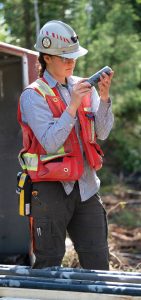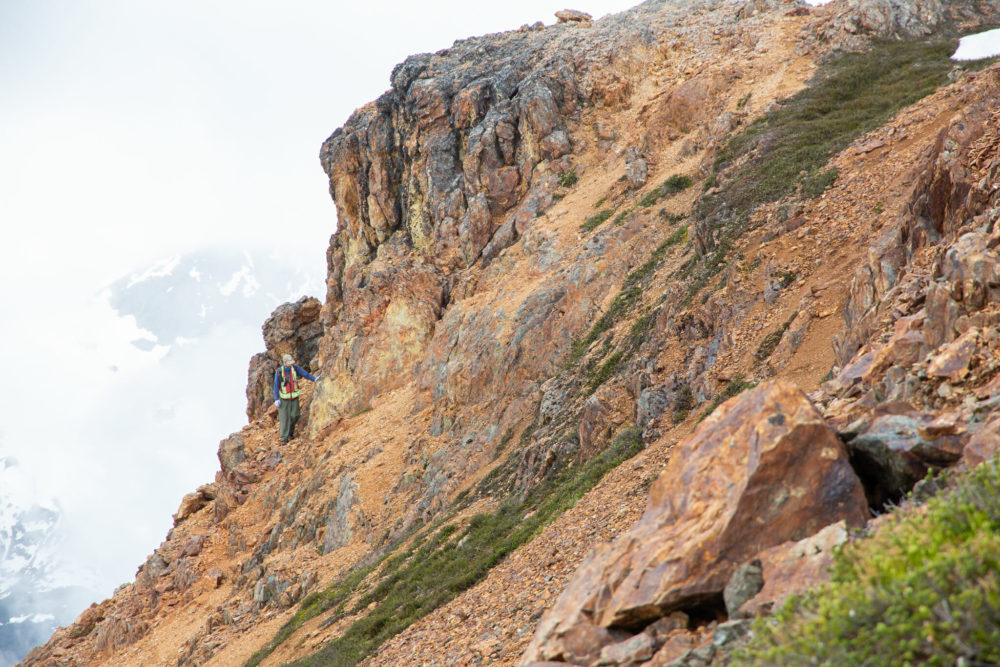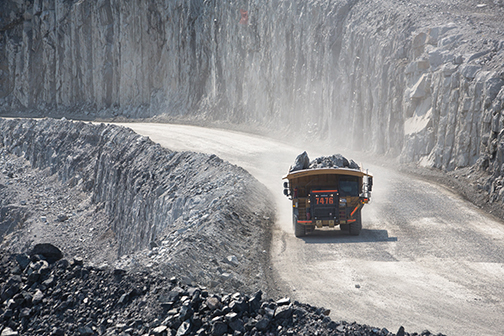Great Bear upends the Red Lake model

Examining drill core at Great Bear Resources’ Dixie project, in Red Lake, Ont. Credit: Great Bear Resources
It wasn’t easy for Great Bear Resources to scrape enough money together for its first drill program at the Dixie project in Red Lake, Ont., in 2017.
The company, relying on financing from a few shareholders, including president and CEO Chris Taylor and vice-president exploration Bob Singh – plus a crucial $100,000 Junior Exploration Assistance Program (JEAP) grant from the province of Ontario – managed to cobble together $200,000 for an extremely modest 1,000-metre drill program.
“It was very difficult early on to get the funding,” Taylor says. “People didn’t believe in the project.”
While the project had already seen 171 holes drilled by previous operators, Great Bear’s fifth hole at Dixie returned the best intercept to date: 10.4 metres of nearly 16.84 g/t gold.
Since then, the company has made several discoveries at Dixie and this year, it’s conducting a fully funded $21-million exploration program, and planning more than 100,000 of metres of drilling with four to five drill rigs.
“What we really want to show everybody by the end of the year is that we have a very significant mineralized zone that has few parallels in terms of dimension and gold endowment in the country,” Taylor told CMJ late January. “That’s our primary goal and it’s ultimately the drill rig that turns that concept into reality.”
‘The wrong rocks’
How did Great Bear go from struggling junior to having $30 million in the bank, a market cap of over $400 million and a share price above $9 a share at press time? It has to do with the company’s methodical approach, led by Taylor, a structural geologist by training, and Singh, a computer model-driven explorationist.
There were several reasons there were few early believers in Dixie’s potential. The project had quite a few strikes against it: though only a 15 minute drive from downtown, it was southeast of Red Lake – not in the same area where so many of the gold deposits in the mining camp are clustered. There’s also very little bedrock exposure on the property, so it was uncertain whether it contained the “right type of rocks” from the Red Lake model perspective.
In fact, some of the historic work had turned up felsic volcanics and sediments, light-coloured rocks that are different chemically from the dark-coloured mafic and ultramafic rocks found at the main mines in Red Lake, and definitely considered the “wrong rocks.”
However, early on in evaluating Dixie before acquiring the property in 2015, it became evident to Taylor and Singh that the existing data on the project was flawed. Dixie had seen 171 holes drilled between 1984 and 2014. But even in zones that had typical Red Lake mineralization hosted in mafic rocks, previous operators made mistakes. While Teck did quality work at the project and made a discovery in the late 1980s (the 88-4 zone), juniors that subsequently explored Dixie didn’t have the tools or budgets to deal with the magnetic quality of the rocks in those zones.
“That rock is so magnetic, it’s difficult to line up the drill rigs properly if you’re just using a compass, and locate the drill holes accurately,” Taylor says. “Some of the holes were off by up to 80 metres and going the wrong direction.”
All of that meant that previous owners’ interpretation of the geology at Dixie, which was thought to contain disparate gold zones, could also be flawed.
“Bob replotted all the data and did up a quick three-dimensional model of the original zone,” Taylor recalls. “Instead of having, like previous groups have interpreted, a bunch of discontinuous lenses of gold – even though there were drill holes that were poorly recorded and going the wrong direction – you could still see that it was a very compelling sheet of gold mineralization going from surface down to about 450 metres and it looked like it would be a plane – like a predictable sheet of gold.”
With that realization, Great Bear acquired 67% of the project in 2015 and then the spent a year and a half relogging historical core, cleaning up, re-evaluating and reinterpreting the data to get a solid understanding of the geology before doing any drilling.
“We relogged all the historical core we could find, even when it was in the ‘wrong rocks’ and found high-grade visible gold in it. Then we began to realize that this big target that we had down the middle of the project was probably a very good gold host,” Taylor says, referring to the LP Fault. “That was part of the equation – we didn’t have a particular model in mind when we went exploring, we just followed the gold and followed the data.”
At the same time, Taylor restructured the company and brought it into John Robins and Jim Paterson’s Discovery Group (both Robins and Paterson are advisors), brought in a new board, and did a share rollback.
Discoveries
Back to that fifth hole that Great Bear drilled at Dixie in 2017, which became the Dixie Limb discovery: “That was the best hole on the project to date and the reason we were able to drill it was because we understood, based on cleaning up the data carefully beforehand, that we had these predictable gold sheets of high grade mineralization and that really started to get the ball rolling,” Taylor said.
“We fixed up a lot of the historical data and ultimately began making a series of discoveries by not cutting any corners geologically,” Taylor says. “Oriented drill core, surveying all the drill collars, assaying holes top to bottom – that led to a sequence of major gold discoveries which have brought the company to where it is now.”
The company has made several discoveries at Dixie over the last three years, including the Dixie Limb zone (2017), Hinge zone in 2018 (which has returned up to 16.3 metres of 26.91 g/t gold), and the LP Fault deformation zone last year. Because of its size, the LP Fault has become the main target for this year’s drill program – it’s been drilled along 4 km of its interpreted 18-km strike length.
Results from the LP Fault have included: 18.2 metres of 10.32 g/t gold from 58.8 metres depth; 8.7 metres of 48.67 g/t gold from 251.6 metres depth; and 42 metres of 5.28 g/t gold from 90 metres depth. The LP Fault contains six zones: Viggo, Auro, Yauro, Yuma, GAP and Bear-Rimini.
Dixie Limb and Hinge have been drilled to a depth of about 500 metres and are still open. The LP Fault zone, about 500 metres away, has also been drilled down to around 500 metres.
The zone, which appears to get wider with depth, and return more high-grade intervals, is completely open, with the company conducting stepout, infill and step-down drilling.
It’s clear now that Dixie hosts two main styles of gold mineralization. The first is typical for Red Lake – high-grade gold in quartz veins and silica-sulphide replacement zones. Hosted in mafic volcanic rocks and localized near regional-scale D2 fold axes, this is the type of mineralization found at Dixie Limb and Hinge.
The second type is high-grade disseminated gold within wider moderate to lower-grade zones. Hosted in light-coloured felsic volcanic rocks, this is the type of mineralization found in the LP Fault.
Previously, when explorers hit felsic rocks in Red Lake, they would stop the drill hole and move on as they were considered the “wrong rocks” to host gold.
“This had happened on our project,” Taylor says. “The LP fault, which is a multi-kilometre high-grade gold zone that has these big bulk-tonnage grade halos around it, they had drilled into that rock and because it was the light-coloured felsic volcanic rock, they had shut down the holes and hadn’t even assayed a lot of that drilling. There was high-grade visible gold in that rock that had been left there by past explorers but never assayed.”
‘Big scale’
All told, Great Bear paid only $210,000 for a 100% interest in Dixie with no underlying royalties. After acquiring the initial majority interest, it acquired the remaining 33% stake from Newmont (which had inherited the project through M&A) in 2017.
Interestingly, Great Bear hasn’t felt the need to rush to compile an initial resource for the project.
A first resource estimate is planned for early 2021 – by which time the company will have completed 200,000 metres of drilling, in addition to drilling by previous operators.
Sure that it’s onto something big, Great Bear wants to ensure that its shareholders get exposure to any potential future production at Dixie – regardless of the owner – and has proposed to spin out a 2% net smelter return royalty on the project.
“At Dixie, because it has this big scale that looks very impressive, if, in the future we become an acquisition target, we want to make sure our shareholders that put all this risk equity in very early on in the discovery process benefit over the long term,” Taylor says.
As royalty companies are some of the most profitable businesses in the mining space, shareholders could reap substantial rewards from the spinout, which won’t be listed right away.
“Based on the size of the system that we’re looking at right now, the only parallels that we can really point to are big deposits that we know about from other areas,” Taylor says. “Geologically, we have some very strong similarities to the Hemlo camp. That’s also felsic geology hosted, it’s disseminated high grade gold in predictable sheets along a strike length of about 2.6 km whereas we already have a drilled strike length of more than 4 km.”
Revisiting Red Lake geology
The company’s new understanding of Red Lake geology has been a “game-changer,” Taylor says – and the industry is paying attention.
“Most of the gold that we found has been in “the wrong rocks” – these felsic rocks,” he says, noting that there are belts of felsic rocks across the Red Lake area that are underexplored.
“It may be that the rocks themselves are not the key factor – it’s the big fault zone that goes down to the bottom of the continental crust which has all of our gold in it,” Taylor concludes. “But it has opened people’s eyes to the fact that there’s a new story to be told in the Red Lake area which doesn’t fit into the old models.”





Comments